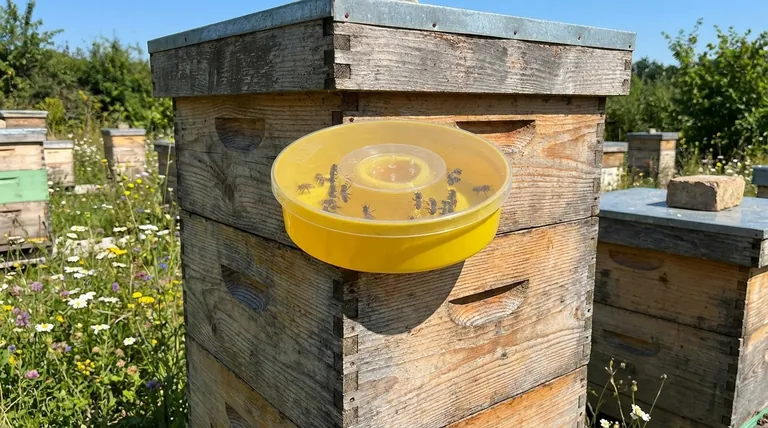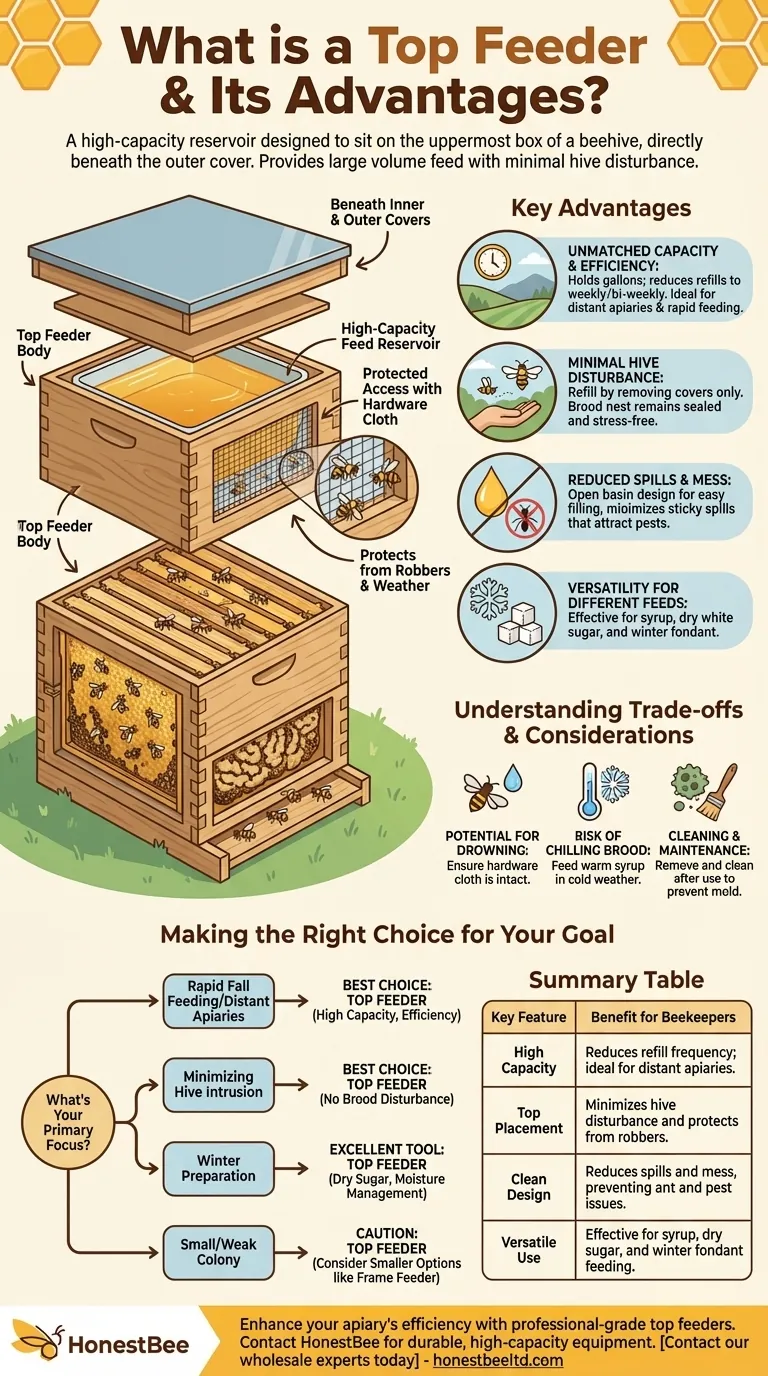At its core, a top feeder is a high-capacity reservoir designed to sit on the uppermost box of a beehive, directly beneath the outer cover. Its principal advantages are efficiency and minimal hive disturbance, allowing a beekeeper to provide a large volume of feed with fewer visits and without disrupting the colony's critical brood-rearing space.
The top feeder's design solves a central problem in apiary management: how to deliver a significant amount of food to a colony quickly, safely, and with the least possible stress to the bees. It is the preferred method for high-volume feeding.

The Design and Function of a Top Feeder
How It's Constructed
A top feeder is typically a shallow wooden box, around four to five inches deep, built to the same dimensions as an 8-frame or 10-frame Langstroth hive body.
Inside this box is a reservoir, often made of plastic, that holds the feed. A key feature is a protected access area, frequently covered with hardware cloth or a similar screen, which allows bees to reach the syrup without falling in and drowning.
How It's Positioned
The feeder is placed directly on top of the hive's highest box and is then covered by the hive's inner and outer covers. This encloses the feed, protecting it from sun, rain, and wind.
Because of its location, it also shields the feed from robber bees from other colonies, which can be a significant threat when feeding is done in the open.
Key Advantages for Apiary Management
Unmatched Capacity and Efficiency
The defining benefit of a top feeder is its large volume. It allows a beekeeper to provide gallons of syrup in a single visit, drastically reducing the frequency of refills to as little as once every week or two.
This is a massive time-saver, making it ideal for beekeepers managing distant apiaries where frequent visits are impractical. The wide access area also allows many bees to feed simultaneously, enabling the colony to process a large quantity of syrup very quickly.
Minimal Hive Disturbance
Refilling a top feeder is one of the least invasive feeding methods. You only need to remove the outer and inner covers to pour in more syrup.
The brood nest, where the queen is laying and young bees are developing, remains completely sealed and undisturbed. This reduces colony stress, especially during critical periods in the fall or spring.
Reduced Spills and Mess
The open, basin-like design makes top feeders simple and fast to fill, significantly reducing the chance of spilling sticky syrup down the sides of the hive.
Spilled syrup is a major attractant for ants and robbing bees, so this clean design enhances the overall health and security of the colony. Unlike some gravity-fed designs, they are not prone to leaks caused by temperature fluctuations or faulty seals.
Versatility for Different Feeds
While ideal for providing syrup during a nectar dearth or for fall buildup, top feeders are also highly effective for winter feeding.
They are an excellent tool for providing dry white sugar or fondant to the colony in early and mid-winter. The sugar absorbs excess moisture in the hive while providing emergency food directly above the winter cluster.
Understanding the Trade-offs and Considerations
Potential for Drowning
While the hardware cloth is designed to prevent drowning, some bees may still find their way into the main reservoir and perish. It is crucial to ensure the protective screen is properly installed and has no gaps.
Risk of Chilling the Brood
In colder weather, placing a large volume of cold syrup directly above the brood cluster can create a "cold sink," forcing the bees to expend extra energy to keep the brood warm. In such conditions, it is wise to feed syrup at or slightly above ambient temperature.
Cleaning and Maintenance
Because of their size and the presence of sugar syrup, top feeders can develop mold if left empty and unattended in the hive. They should be removed and cleaned thoroughly once feeding is complete.
Making the Right Choice for Your Goal
By understanding its specific strengths, you can deploy a top feeder for maximum impact.
- If your primary focus is rapid fall feeding or managing distant apiaries: The top feeder is the most efficient choice due to its high capacity and ease of use.
- If your primary focus is minimizing hive intrusion: The top feeder allows you to refill without ever breaking open the brood chamber, reducing colony stress.
- If your primary focus is winter preparation: The top feeder is an excellent vessel for providing a large quantity of dry sugar to manage moisture and provide emergency food.
- If you are managing a small or weak colony: Be cautious, as a large feeder may be more space than the colony can defend or access, and other methods like a frame feeder might be more appropriate.
By understanding these principles, you can confidently choose the feeding strategy that best supports your colony's health and your management style.
Summary Table:
| Key Feature | Benefit for Beekeepers |
|---|---|
| High Capacity | Reduces refill frequency; ideal for distant apiaries. |
| Top Placement | Minimizes hive disturbance and protects from robbers. |
| Clean Design | Reduces spills and mess, preventing ant and pest issues. |
| Versatile Use | Effective for syrup, dry sugar, and winter fondant feeding. |
Ready to enhance your apiary's efficiency with professional-grade top feeders? At HONESTBEE, we specialize in supplying durable, high-capacity beekeeping equipment to commercial apiaries and distributors. Our top feeders are designed to save you time and reduce colony stress, supporting healthier, more productive hives. Let us help you streamline your feeding strategy. Contact our wholesale experts today to discuss your needs and place your order!
Visual Guide

Related Products
- HONESTBEE Round Hive Top Bee Feeder for Syrup
- Rapid Bee Feeder White Plastic 2L Round Top Feeder for 8 or 10-Frame Bee Hives
- Professional Hive Top Bee Feeder for Beekeeping
- HONESTBEE Professional Hive Top Bee Feeder Feeding Solution
- Professional Hive Front Entrance Bee Feeder
People Also Ask
- How do hive top feeders work? A Guide to Efficient, High-Capacity Bee Feeding
- How should syrup for bees be prepared? Master the Ratio for a Thriving Hive
- What types of hive boxes is the round hive top feeder compatible with? Universal Fit for 8 & 10-Frame Langstroth Hives
- What safety features are included in top feeders? A Guide to Drowning Prevention and Hive Safety
- How do you set up and use a top feeder for bees? A Step-by-Step Guide for Safe Feeding



















